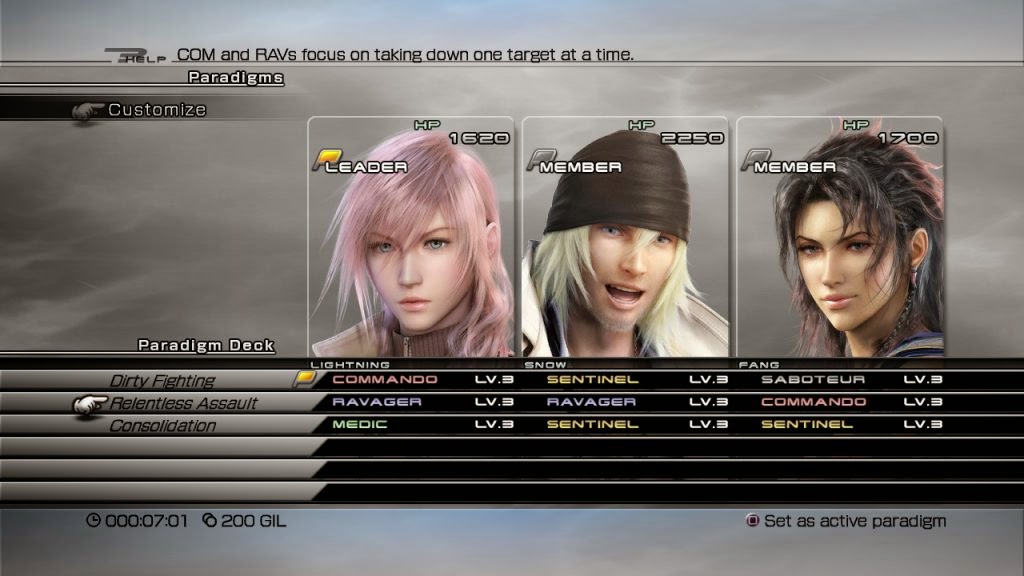Battle System
Given that Final Fantasy I is a role-playing game, the battle system is vital to the games' success. The system for Final Fantasy I (original) is outlined below:
Final Design
Development Process
I based a lot of the battle system on the previous games and did my research into what was successful with the games and what wasn't.
Whilst Square kept up this template for their earlier games, the later games see them experimenting and moving to a range of other systems:
- Final Fantasy VII had a "time-based" system, where instead of the characters taking turns, the characters would move based on when their time bars had fully loaded. Whilst this was still, in effect, turn-based, moves such as haste or slow would directly affect how slowly the bar loaded.
- Final Fantasy X returned to the original turn-based system but with a new element: as X allowed the user to choose between more than four characters, characters could be swapped in in the middle of a battle (previously something the user could only do at a save point/world map)
- Final Fantasy XII attempted a more "real-time" based system, where the user was still able to control the characters movements in battle. The user could run the character up to the monster and attack, then run around to try and dodge. This game also brought into automated battling for the other party members - the user can set "gambits" that determine how an inactive party member (you can switch any time in battle) acts.
- Final Fantasy XIII introduced the "paradigm" system that the franchise is still using as of the latest game. In battle, the three active characters can have their classes altered in order to create combinations. I.E. you could have "combat clinic" which is MEDIC, MEDIC, SENTINEL (tank) when health is running low. Similarly to Final Fantasy XII, the other, inactive party members act automatically based on their class. The party's health also heals immediately after battle.
Proposal
For the Final Fantasy I reboot, this project aims to combine several of the best elements from the battle systems to further the paradigm system that Square is currently working with. This will predominantly be a mixture of Final Fantasy XIII's system and Final Fantasy X's. The main elements will be:
- Ability to switch characters in battle - as there are only four main playable characters, there are less party options and thus, it makes more sense and is less frustrating/effort for the player to switch characters in with ease. It also allows for more strategising.
- Each character will have three classes (more on classes here) and the user will be able to pull up the Paradigm menu to change the current classes active.
- Like Final Fantasy XIII, and to a degree, Final Fantasy XII, the user will be able to use an "auto battle" command to execute a simple attack, or has the option to choose a more complex sequence of movements. This reflects the same system as Final Fantasy XIII, and also places more emphasis on the use of paradigm shifts and classes as being the primary way of strategy - most boss battles will require a good knowledge of the classes and shifts.
Setting Paradigms in Final Fantasy XIII
Limit Breaks/Overdrives/"Special Abilities"
The previous games have always allowed the characters a "special ability" or "special move" that does extra damage to an enemy. This was called a 'Limit Break' in VII, an 'Overdrive' in X, and 'Mist' in XII. This was eliminated in XIII in place of the stagger system. The stagger system provides all enemies with a stagger bar, which when reached, makes them vulnerable allows all characters attacking to do extra damage to an enemy. Whilst it is clear why this was chosen over characters' individual moves, this reboot will return to the original system.
Applying Vincent, Final Fantasy VII's limit break
By having each individual character have their own unique set of moves, it further adds to the user's engagement with them and prompts them to further develop their abilities, and thus to continue the game. Whilst the stagger system was effective, it did not help with characterisation as it removed the chance for characters to be able to have their own unique moves.
Thus, Final Fantasy I will return to the "limit" bar growing as the character takes damage. Whilst the characters reach their limits in Final Fantasy VII, they will reach Outrage in Final Fantasy I reboot, which will allow them to execute a powerful move.
Summons
Summons are used in all Final Fantasy games. Whilst some (Final Fantasy VII, VIII,) allow all characters to use summons, Final Fantasy X had only the summoner character, and Final Fantasy XIII had each character assigned an "eidolon". Final Fantasy I reboot will continue on with this system, as the main aim is to create a character-driven game and narrative. By providing set summons to each character, it allows for further characterisation and development.
Previous: Gameplay Menu | Next: Level System









No comments:
Post a Comment